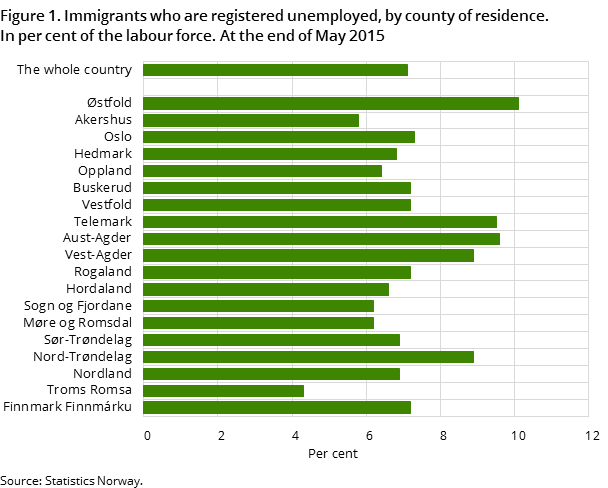Content
Published:
This is an archived release.
Male EU immigrants had strongest increase
The registered unemployment rate among immigrants settled in Norway increased from 7.0 per cent in May 2014 to 7.1 per cent in May 2015. In the rest of the population, this rate increased from 1.9 per cent to 2.0 per cent. In both groups, only men experienced a growth in the unemployment rate.
| 2nd quarter 2015 | Change last twelve months | |||
|---|---|---|---|---|
| Absolute figures | Per cent | 2nd quarter 2014 - 2nd quarter 2015 | ||
| Absolute figures | Percentage points | |||
| 1Non-residents included. | ||||
| 2Turkey is included. | ||||
| Registered unemployed, total | 74 994 | 2.7 | 2 501 | 0.1 |
| Non-immigrant population1 | 45 709 | 2.0 | 1 164 | 0.0 |
| Immigrants, total | 29 285 | 7.1 | 1 337 | 0.1 |
| The Nordic countries | 1 532 | 3.0 | 155 | 0.3 |
| Western Europe else | 1 674 | 3.7 | 222 | 0.4 |
| EU countries in Eastern Europe | 10 594 | 8.6 | 1 471 | 0.9 |
| Eastern Europe else | 2 344 | 6.7 | -11 | -0.2 |
| North-America and Oceania | 222 | 3.3 | 18 | 0.2 |
| Asia2 | 7 821 | 7.6 | -408 | -0.6 |
| Africa | 4 128 | 11.8 | -198 | -1.5 |
| South- and Central-Amerika | 970 | 7.3 | 88 | 0.5 |

The number of registered unemployed immigrants increased by 1 300 during this period. Immigrants from EU countries in Eastern Europe had the strongest growth by almost 1 500. Immigrants from Asia and Africa had, on the other hand, a decline of about 600 unemployed. In the majority population, the number unemployed increased by 1 160.
Immigrant men had an increase in the unemployment rate of 0.4 percentage points, while immigrant women experienced a decline of 0.3 percentage points. In the rest of the population there was an equivalent pattern of change, i.e. an increase of 0.1 percentage point among men and a similar decline among women.
In total, almost 75 000 people were registered as unemployed in the 2nd quarter of 2015. Of these, about 29 300 were immigrants, which is a share of 39 per cent of the total unemployed.
Various changes within the immigrant groups
The changes in the unemployment rate from May 2014 to May 2015 varied considerably within the immigrant groups. Immigrants from the EU countries in the east had a growth of 0.9 percentage points, while those from Western Europe and the Nordic countries had increases of 0.4 and 0.3 percentage points respectively. On the other hand, immigrants from Africa and Asia had decreases of 1.5 and 0.6 percentage points respectively. There were also increases of 0.5 percentage points among immigrants from Latin America and 0.2 percentage points among those from North America and Oceania.
Large disparities among immigrants
Despite the decrease in the unemployment rate, immigrants from Africa had still the highest unemployment level, at 11.8 per cent in the 2nd quarter. This was followed by immigrants from the EU countries in the east, with 8.6 per cent unemployed. The groups from Asia and Latin America had rates of 7.6 and 7.3 per cent respectively, while the corresponding figure for those from Eastern Europe outside the EU was 6.7 per cent.
Despite the increase, the remaining groups continued to have rates far below the immigrant average. Among immigrants from Western Europe, unemployment was 3.7 per cent, and among those from North America and Oceania, it was 3.3 per cent. Immigrants from the Nordic countries had the lowest rate, at 3.0 per cent.
Male immigrants had an unemployment rate of 7.2 per cent in the 2nd quarter, while the corresponding share for female immigrants was slightly lower, at 6.9 per cent. In the rest of the population, the rates for men and women were 2.3 and 1.6 per cent respectively.
Continued decline among participants on labour market schemes
The decline in the number of participants on labour market schemes continues. There were 781 fewer participants among immigrants in May 2015 than in May 2014, which is a decline of 12.3 per cent within this participant group. Among participants in total, the decline was 9.7 per cent. A total of
5 574 immigrants participated in labour market schemes in the 2nd quarter of 2015, making up 41 per cent of the total participant group. As in previous years, the majority of the immigrant participants were from Asia and Africa.
Lower unemployment among Norwegian-born to immigrant parents than immigrants
Norwegian-born to immigrant parents is still a rather small group of unemployed. This group made up slightly more than 1 000 registered unemployed in the 2nd quarter of 2015. A large share of this group are aged 15-29 years, and the unemployment rate within this age group was 4.4 per cent, which was 3.5 percentage points below the immigrant group at the same age (7.9 per cent) and 1.4 percentage points higher than the corresponding age group in the rest of the population (3.0 per cent).
The unemployment rate decreased within all three population groups aged 15-29 years. The decline was strongest among Norwegian-born to immigrant parents by 0.8 percentage points, while the other two population groups both had a decline of 0.4 percentage points.
Additional information
The unemployment figures are based on the Norwegian Labour and Welfare Organisation’s register of jobseekers and are calculated as a share of the labour force, which is the sum of employed persons and registered unemployed persons, i.e. people offering their labour on the labour market.
Contact
-
Statistics Norway's Information Centre
E-mail: informasjon@ssb.no
tel.: (+47) 21 09 46 42
